Synthetix Review: Decentralised Synthetic Asset Protocol
Synthetix is one of the most interesting Decentralised Finance (DeFi) projects currently in the space. A distributed asset issuance protocol on a blockchain.
Built on the Ethereum network, this project enables users to issue and trade synthetic decentralised assets. This includes not only your typical blend of cryptocurrencies but also Fiat currencies and even commodities.
However, is it really safe and how does it work?
In this Synthetix review, I will take an in-depth look at the project. I will also give you what you need to know to use the platform and trade decentralised synthetics. But first, let's start with some basics...
Promise of DeFi
One of the main promises that many cryptocurrencies make is to create a type of money and transactional system that is universally accepted. With cryptocurrencies you should be able to pay anyone for anything, no matter where in the world the two of you are. And your transactions should come with minimal fees.
That’s how the creator of Bitcoin envisioned the use of transactional cryptocurrencies just over a decade ago.
Now the blockchain space has evolved, and the Decentralized Finance (DeFi) movement is attempting to take that original premise even further. If the DeFi movement is successful everyone on the planet will have easy and open access to a complete range of financial services, all without the need for banks, or third-party intermediaries.
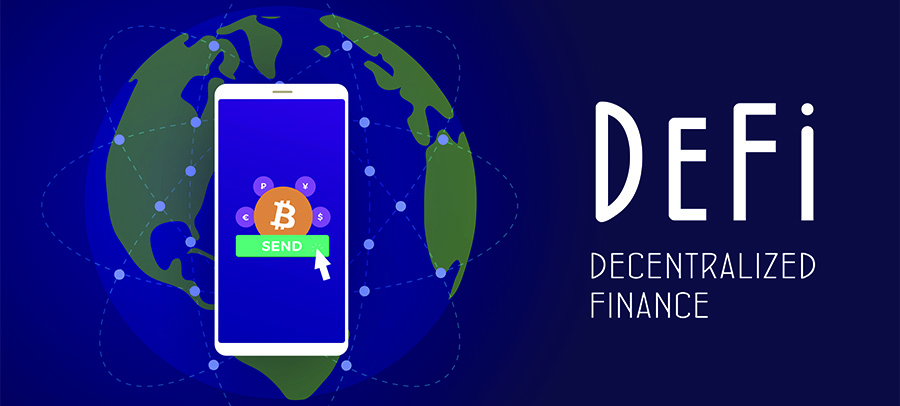
People will be able to access insurance products, loans, investments, savings accounts, and far more. All of this will reside on a blockchain and it will be accessible to anyone with an internet connection and a smartphone or other internet capable device.
All of this is already possible on blockchains with smart contract capabilities, such as the Ethereum blockchain. These smart contracts are applications that execute automatically when certain conditions are met. With smart contracts developers are able to add very sophisticated functionality to the blockchain beyond the simple transactional sending and receiving of cryptocurrency.
If you think this all sounds like something that’s futuristic and little more than a dream, think again. There are already decentralized applications (dApps) that take advantage of smart contracts. These dApps will allow two complete strangers on opposite sides of the globe to negotiate loans without any bank or other intermediary necessary.
The Ethereum network also allows for the creation of new tokens built on top of its blockchain. Many projects have taken advantage of this capability to expand on the functionality of the Ethereum blockchain.
Enter Synthetix
Synthetix is one such project which has a cryptocurrency built on the Ethereum blockchain. Synthetix was created as a DeFi project that will allow for the creation of synthetic assets.

These synthetic assets are able to track the price of any other asset, whether that’s currencies, equities, bonds, commodities, or even other cryptocurrencies. If it’s something that has real world value, then the Synthetix platform will allow a synthetic asset to be created to track the price of that asset.
The mechanism behind Synthetix is much like the one used by stablecoins to maintain their pegged value. But rather than a single stablecoin, Synthetix will allow anyone to mint a synthetic asset backed by the SNX token.
Synthetix perpetual futures are a set of permissionless and decentralized smart contracts, offering deep liquidity and low trading fees on a range of synthetic assets. More recently, founder Kain Warwick introduced a new derivatives front-end called Infinex to the decentralized trading infrastructure of Synthetix.
The planned decentralized exchange (DEX) will cater to both novice and experienced traders by offering features similar to centralized exchanges (CEX), such as a noncustodial central limit order book. It will offer access through a username and password while maintaining a noncustodial setup. Infinex would generate a unique public-private key pair for each user, stored locally in the browser. However, this key cannot withdraw funds. It's only used to sign trades sent to the account relayer on Optimism.
Infinex will launch alongside Perps V3, which is currently in development.
Details Behind Synthetix
As was mentioned above Synthetix was created on the Ethereum blockchain. Unlike most other blockchain projects it includes two different types of tokens:
- The main token which is used in the creation of synthetic assets is called the Synthetix and it uses the ticker symbol SNX.
- The second token type is called the Synth. These are all the synthetic assets that are created using the Synthetix platform.
From the outside the system for using Synthetix is quite straightforward and simple. Users first purchase SNX tokens and then lock them in a compatible wallet. Once they’ve locked up the SNX tokens they can be used to create Synths to track the price of some other real-world asset.
This is where things get a little more complicated. The price of each Synth is determined by oracles, and many of these have already been provided through a partnership with Chainlink (LINK).
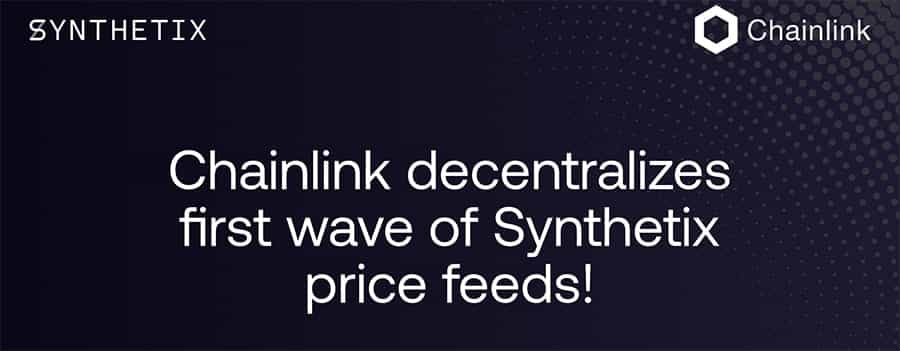
At this point the Synths available are primarily currency or cryptocurrency pairs. There are also Synths available based on gold and silver, and all the Synths can be traded and exchanged at the Synthetix Exchange.
It’s incredibly easy to create Synths that track prices in whatever way the creator intends. For example, there are Synths based on Bitcoin, and the sBTC tracks the price of Bitcoin, but the iBTC is an inverse token which gains in value when Bitcoin falls in value.
Those are two of the simplest uses for Synthetix and Synths, but the ability to mint and own Synths based on different criteria will encourage many new ways to trade assets, to create and manage portfolios of assets, to hedge, and even to make payments.
Unique Features
There are four features that are unique to Synthetix and can’t be found in nearly any other system.
- Anyone can create and convert Synths without the need for a counterparty;
- Any Synth can be traded for any other Synth on the Synthetix Exchange and the functionality provides nearly infinite liquidity
- Peer-to-contract (P2C) trading in which trades are executed quickly and easily, all without an orderbook.
- A distributed pool of token holders is responsible for providing collateral on the platform and for maintaining the stability of the exchange.
What Can You Trade?
Currently you can trade Synths and inverse Synths of major currencies like the euro, yen, pound sterling, U.S. dollar, Australian dollar, Swiss franc, and others.
You can also trade Synths and inverse Synths of cryptocurrencies such as Bitcoin (BTC), Ethereum (ETH), Ripple (XRP), Tron (TRX), Chainlink (LINK), and others. And there is a Synth and inverse Synth that allows trading gold and silver.

Theoretically though you can trade any asset with Synthetix. The financial system includes derivatives, commodities, equities, and other assets that add up to hundreds of trillions of dollars. And Synthetix provides a platform where any of these assets can be turned into a synthetic asset that lives on the Ethereum blockchain.
This allows them to be traded in a permissionless and decentralized manner, which is in contrast with the traditional markets that are controlled by centralized institutions.
Synthetix will allow anyone, anywhere in the world, gain access and exposure to global equities like Facebook or Deutsche Bank without the need to deal with the extreme friction created by the centralized financial institutions and government regulations.
Even crypto traders can benefit through the access to a basket of cryptocurrencies in both long and short Synths.
How Synthetix Remains Collateralized
The primary problem experienced in the Synthetix system is in keeping the system collateralized.
I’m sure you’ve already thought what might happen if the value of the Synths on the platform begin moving in opposition with the underlying SNX tokens. How could the system maintain its collateralization if the price of SNX were dropping, while the price of the Synths was rising?
In fact, the infinite liquidity of the platform was created to help solve that problem, and there are additional features and characteristics that have been baked in to ensure that the platform continues to function regardless of the price movements of the SNX tokens and the Synths that have been created.
Below you can find out more about each of these features and characteristics.
750% Collateralisation required
In order to issue a new Synth the Synthetix system requires collateralization of 750%. This means to mint 100 synthetic USD (sUSD) a user needs to lock up the equivalent of $750 in SNX tokens.
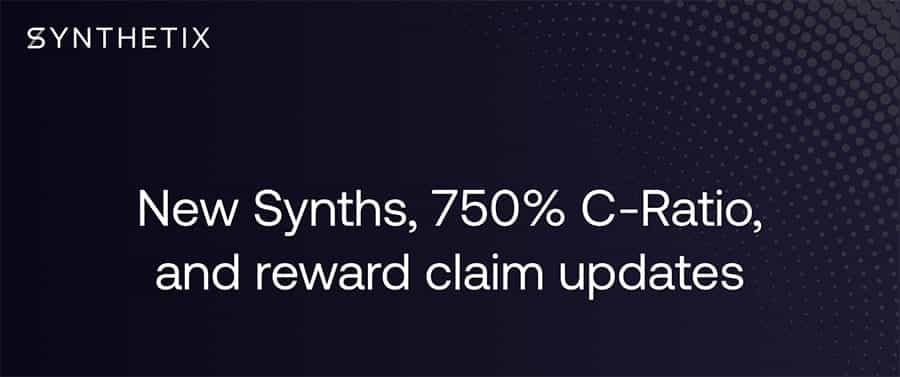
This large collateralization requirement creates a large buffer for the Synths in circulation and protects against sudden market moves.
Debt-driven
In the Synthetix system the SNX collateral is locked up whenever Synths are minted, and those Synths then take the form of an outstanding debt on the platform. If a user wishes to unlock their SNX later they need to burn an number of Synths that is equal to the current value of the Synths they minted earlier.
The 750% collateral requirement ensures that it is easier for users to buy back their own debt when they desire to do so.
Debt Pools
As you can guess each person who creates Synths will have their own personal debt from the Synths they’ve minted, but there is also a global debt pool that underlies the entire circulation of Synths.
In the case of the personal debts, they are simply calculated as an ever-changing percentage of the total Synths minted and in circulation and the exchange rates of the underlying asset and of SNX.
One offshoot of this is that issuers are not required to repay their debt with the exact type of Synth that was initially minted. Issuers can repay their debts with any type of Synths, so long as it has the same market value as the value of the Synths they wish to burn.
This is the mechanism that gives the Synthetix platform what appears to be infinite liquidity. It also allows for any shifts between Synths in the system without creating an imbalance.
Synthetix Exchange
The Synthetix Exchange is where people can go to buy and sell all the various Synth that’s been created. Because the exchange is underpinned by smart contracts there is no need for reliance on any counter-party or third party in the exchange process. Anyone can buy and sell at any time, tapping into the infinite liquidity of Synthetix.
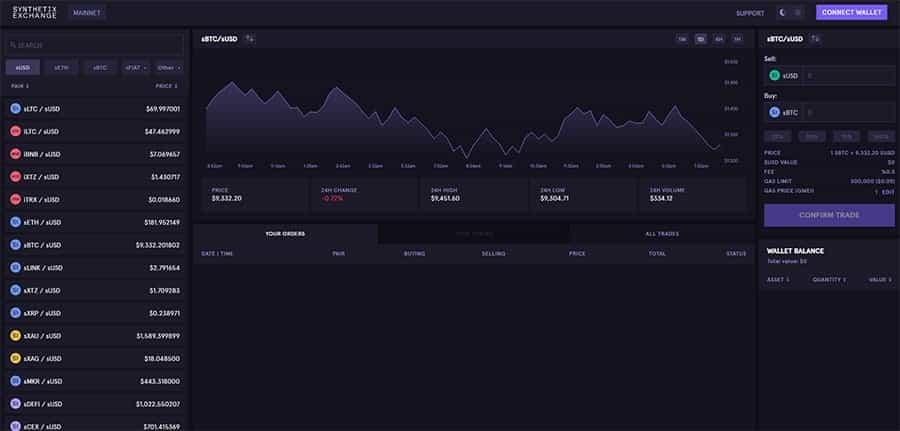
Accessing and using the exchange is easily accomplished by connecting a web3 wallet to the exchange. Once that’s been accomplished users can quickly and easily convert between different Synths and SNX.
Currently the exchange fee for all assets on the exchange is 0.3%. These exchange fees provide incentive to hold SNX tokens since they are distributed to SNX holders as a reward for providing the system with collateral to back the Synths in circulation.
Inflation
The developers of Synthetix have built inflation into the system too, with the total amount of SNX issued planned to increase from the initial 100 million tokens to 250 million tokens by 2025.
This inflation was not originally built into the system, but was added later when it became obvious that exchange fees alone would not be an adequate incentive to issue Synth. The inflation will be distributed among the Synth issuers, giving them an added incentive to mint new Synth.
Exchange fees and Staking Rewards
Anyone is able to purchase SNX and lock it in a wallet, issue Synth, and take on the debt behind those Synth. When this process is done the user becomes a staker in the Synthetix ecosystem and they can earn and collect staking rewards. The staking rewards come from Sythetix Exchange fees, which are currently set to 0.3% of each transaction.
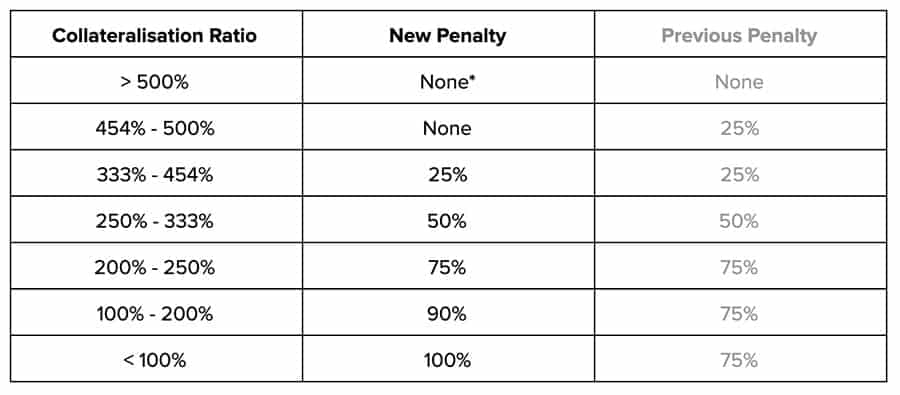
As each transaction on the exchange takes place the exchange fees are transferred to a pool. This pool is then distributed among SNX stakers in proportion to the amount of outstanding debt they hold. In this way anyone can increase the amount of staking fees they earn by simply issuing more Synth.
One caveat to this system is that stakers can only earn and collect staking rewards if they keep their collateralization at or above 750%. This incentivizes Synth issuers to keep their collateral at 750% and maintains the liquidity of the system.
How Does it Work?
The actual process works very smoothly. It begins by holding SNX tokens in an ERC-20 compatible wallet and then connecting that wallet to the Synthetix Exchange (beta v.2 here).
If a user wishes to stake their SNX tokens, or wants to mint Synth for some purpose they begin by locking SNX as collateral in their wallet. Remember there is a 750% collateral requirement, so all Synth is minted relative to this collateral requirement and the value of the SNX locked in the wallet.
After the Synth is minted anyone anywhere in the world is able to access it in order to trade, invest, pay transactions, or do anything else necessary with the Synth.

Those who create Synth are also considered to be stakers in the system, and they earn staking rewards based on the amount of SNX locked, and based on the fees generated by the Synthetix Exchange. So, the more the Synthetix Exchange is used the greater the total fees generated and the larger the reward pool for stakers.
Keep in mind it isn’t necessary to mint Synth if you just want to buy and sell Synth. Anyone can use the Synthetix Exchange. All they need is an ERC-20 compatible wallet with some ETH for gas and some Synth. If the user doesn’t own Synth yet they can use ETH to purchase sUSD.
To make things even easier there is an application called Mintr that was created to make the minting of Synth and staking SNX as simple as posssible.
Mintr
Mintr is a dApp that was created as an intuitive interface for managing SNX, Synths, and all the aspects of the Synthetix ecosystem.
Through the Mintr interface users can perform a wide range of activities related to the broader Synthetix ecosystem. This includes minting and burning Synth, lock and unlock SNX, collect staking fees, send sUSD to a selling queue, manage the collateralization ratio, and more.
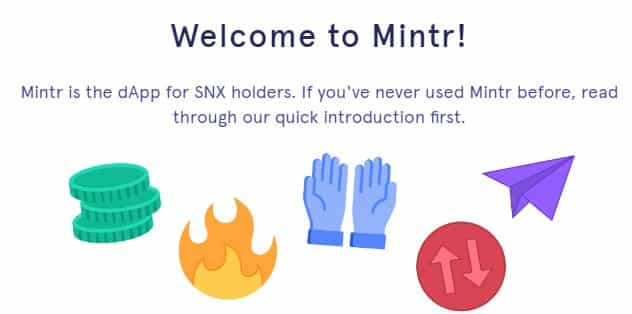
Users are able to connect their ERC-20 compatible wallet to Mintr in order to perform any of the tasks mentioned above. Mintr makes managing SNX and Synth as simple as possible.
Synth Pegging Mechanism
It is critical that Synthetix maintain a stable peg so that the system remains stable, with good liquidity in a well-functioning system. This is required if traders are expecting to use the system to generate profits.
Because some Synths are trading on the open market there is always the possibility that the Synth will fall below par in comparison with the asset they track. This means incentives are needed to keep any deviations minimal, and to give users an incentive to correct any deviations.
These are the three methods used to maintain the Synth peg:
- Arbitrage – When SNX stakers mint Synth they create a debt which can be arbitraged on if the peg is broken. In practice it means they can buy sUSD below par and burn that to reduce their debt at a lower cost basis.
- sETH Liquidity Pool on Uniswap – Each week when new SNX is created a portion is distributed to those users who are providing sETH/ETH liquidity on Uniswap This incentive is responsible for creating the largest liquidity pool for the Synthetix Exchange. Because of this massive liquidity pool it allows anyone to easily buy and sell any Synth at any time.
- SNX Arbitrage Contract – There is a contract holding SNX whereby users can send ETH to the contract anytime the sETH/ETH falls below par. The contract exchanges the ETH for SNX at par value. This allows anyone to exchange ETH for SNX at a discounted rate anytime the sETH ratio falls too low.
The Synthetix Team
Synthetix was originally conceived and created as Havven in 2017 by Kain Warwick in Sydney, Australia. As Havven the project raised roughly $30 million in an ICO that was held in March 2018. One of the largest investors in the project was Synapse Capital, a crypto-investment firm that focuses on crypto native projects and developer network effects.
In late November 2018 the Havven team announced they would rebrand the project to Synthetix, and in the first week of December 2018 the rebranding took place.
The leader of the Synthetix project is Kain Warwick, who built Australia’s largest cryptocurrency payment platform prior to starting work on Synthetix.

In the CTO position at Synthetix is Justin Moses, who has been with the project since its inception. Prior to joining Synthetix he was the Director of Engineering at MongoDB. He has extensive experience with large scale systems, including both the design and deployment.
Senior architect for the project is Clinton Ennis who has 18 years experience in software engineering. He was previously an Architect Lead at JPMorgan Chase.
Synthetix (SNX) Token Overview
SNX tokens power the entire Synthetix ecosystem, since they are used as collateral to mint the Synths, or synthetic assets. Those who hold SNX tokens can stake them and earn a portion of the fees generated by the Synthetix Exchange.
The SNX was deflationary until March 2019, when the Synthetix team added an inflationary monetary policy component to help incentivize users to create Synths. After this inflationary policy was implemented the Synthetix network saw a huge jump in user participation, and an accompanying jump in the value of the SNX token.
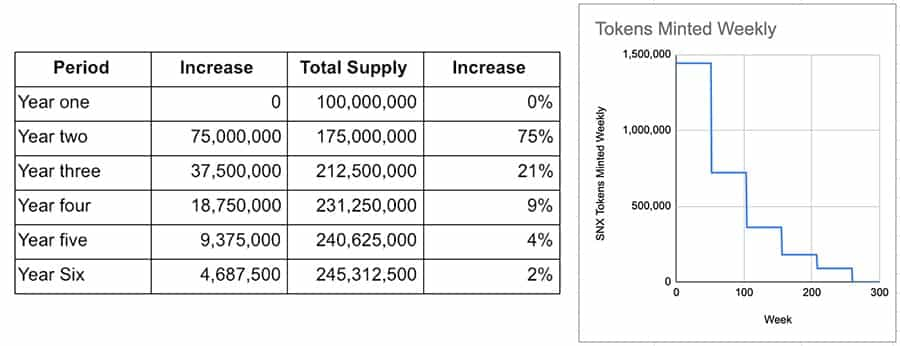
The inflationary policy includes increasing the number of SNX tokens from 100 million in March 2019 to 260,263,816 by August 2023. The issuance of new tokens decays at a rate of -1.25% per week. After the supply reaches the August 2023 goal the protocol shifts the issuance rate to a fixed 2.5% inflation rate in perpetuity.
Even though the SNX token isn’t designed as an investing tool itself, the token has seen massive growth since the March 2019 introduction of an inflationary mechanism. At that time the token was trading at just under $0.05, but as of January 2020 it is at $1.20 after reaching an all-time high of $1.57 on November 24, 2019.
Concerns with Synthetix
While Synthetix sounds futuristic and has a number of unique benefits that could serve many individuals around the world, there is still a large risk with the system, and that’s the fact that it’s still in development and there’s no guarantees it will grow and succeed in the long term.
For users there is a very real risk that they would need to burn more Synths in the future than they issued in order to unlock their SNX. There’s also a risk of competition rising and overtaking Synthetix.
Other risks include Synthetix’s dependence on Ethereum, and the current centralization of the project.
The platform also needs reliable price feeds for all the synthetic assets minted and listed in the Synthetix Exchange. If there’s no way to reliably track the price of the asset without manipulation the whole system will be subject to fraud.
This need for reliable price feeds has kept Synthetix limited to major currencies, high liquidity cryptocurrencies, and commodities such as gold and silver.
In the future it’s possible regulatory changes will also impact Synthetix. Some jurisdictions could easily classify the Synths as securities or financial derivatives, which would make them subject to all the current regulations and laws governing those asset types.
2020 Roadmap
The Synthetix team listens closely to the community, so any of the potential changes listed below are only possibilities for 2020 and could easily change based on community feedback.
Growth/Adoption
- Additional Synths, including leveraged Synths;
- Synthetic equities and indices;
- Synthetic positions;
- Binary options;
- Website upgrade.
Mechanism/Incentive Design
- Full use of Ether as collateral;
- Additional Uniswap pools to improve liquidity;
- Upgrade to a “pooled” depot.
User Experience
- Higher throughput through Optimistic Rollups;
- Triggered orders such as stop-loss and limit orders;
- SNX staking pools;
- ERC-20 escrow tokens.
Protocol Security
- Pausing trading during market closures;
- Tracking the P/L of individual wallets;
- Pause functionality added to contracts;
- Unit test audit.
Decentralization
- Decentralized proxy contracts;
- DAO structure phase 1;
- Upgrading The Graph to allow dApps to deploy to IPFS and avoid a central point of failure.
System Optimization
- Optimize the calculation of ‘total issued Synths’;
- Upgraded staking mechanism;
- Refactoring the Synthetix contract;
- Upgrade the deployment process;
- Create a contract address resolver.
Conclusion
Synthetix is at the forefront of the DeFi movement by offering synthetic assets to users across the globe, thus providing access to specialized trading strategies.
Given the massive size of traditional financial markets, which reaches into the hundreds of trillions of dollars, Synthetix has the potential to create a massive tokenized market on the Ethereum blockchain.
It’s a grand and sweeping attempt to revolutionize and modernize the financial markets, and the Synthetix team should be applauded for their vision. However it should also be noted that there is no guarantee their vision will become successful.
There are many factors that could limit the spread of the Synthetix Exchange and the use of Synths.
Disclaimer: These are the writer’s opinions and should not be considered investment advice. Readers should do their own research.
